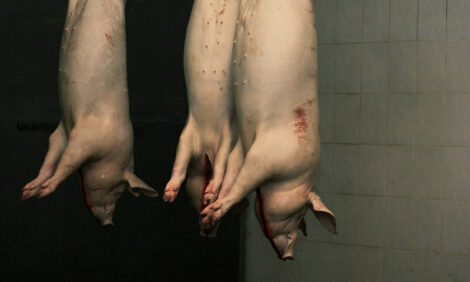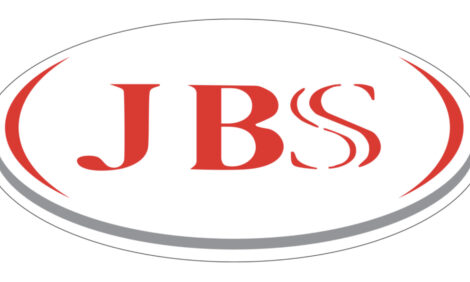



AHVLA Reports Clostridial Disease Causing Neonatal Enteritis in April 2014
UK - The Animal Health and Veterinary Laboratories Agency (AHVLA) reports that during April 2014, clostridial disease causing neonatal enteritis on two units, PRRS underlying bacterial enteric and systemic disease outbreaks, outbreaks of disease due to Haemophilus parasuis with and without PRRS and type A2 congenital tremor in litters of young sows were observed.Alimentary Disease
Late outbreak of enteric colibacillosis in growers with active PRRS virus infection
Enteric colibacillosis was diagnosed at Bury St Edmunds as the cause of six sudden deaths from a group of 180 8-week-old pigs in flatdecks in which some diarrhoea had been noticed. The pigs were vaccinated for Mycoplasma hyopneumoniae and PCV2, but not for PRRS. Gross findings were similar in all three pigs, which were dehydrated and had significant fluid enteropathies mainly affecting the small intestines without mucosal lesions. This was suggestive of enteric colibacillosis which was confirmed by the isolation of enteropathogenic Escherichia coli strain E57 (serotype O138:K81) in pure profuse growths from the small intestines. This diagnosis is unusual at this age, as it is more usually seen in neonatal pigs or immediately post-weaning. Changes in management, pig flow, accommodation, hygiene or antimicrobial treatments might predispose to this late occurrence. Interestingly, none of the pigs were in good body condition and PRRS virus was detected in one, raising the possibility that a PRRSv challenge post-weaning had debilitated pigs and predisposed to disease.
Clostridial disease causing neonatal enteritis on two units
Clostridial enteritis accounted for nearly a third of the cases of enteric disease diagnosed in preweaned pigs by AHVLA in 2013.
Clostridium perfringens enteritis was suspected to be the cause of neonatal diarrhoea affecting approximately 50% of piglets within the first 24 hours of life in three litters in a batch of 27. Small intestinal contents were very fluid. Alpha toxin was detected and testing for beta toxin was inconclusive.
The possibility of type C enterotoxaemia cannot be excluded as beta toxin is quite labile and the sample had taken several days to be submitted: the other alternative was type A disease. Clostridium perfringens was isolated by anaerobic culture.
Two live affected piglets were submitted to Starcross from an outdoor breeding herd experiencing an outbreak of severe diarrhoea in gilt litters at around 4-5 days of age. The piglets were in fair body condition and both had grey-yellow pasty diarrhoea. The herd was vaccinated for PRRS, erysipelas and clostridial disease. Other than watery yellow intestinal contents, gross pathology was unremarkable.
Laboratory testing revealed Clostridium perfringens beta toxin in the small intestinal contents of both piglets and histopathology revealed mucosal necrosis with adherent fibrinonecrotic debris, supporting a diagnosis of clostridial enterotoxaemia due to Cl. perfringens type C. Escherichia coli (987P positive) and Salmonella Bovismorbificans were also isolated from one piglet but were considered to be of secondary clinical significance.
Respiratory Disease
Swine influenza outbreaks in weaners and finishers
Swine influenza was detected in nasal swabs submitted from four-week-old pigs on an indoor nursery finisher site. Approximately 10% of 650 pigs developed a cough shortly after arrival as weaners, and two had died. The strain involved was pandemic H1N1 2009 which is one of the two most common strains currently detected in GB pigs, the other being H1N2.
Two fresh plucks were submitted to Bury St Edmunds from 16-week-old housed finishers on a 2000 pig unit on which respiratory disease, nervous signs and some sudden deaths were occurring. Between 5 and 10% of pigs were reported to be affected, with two dead. Both plucks had approximately 30% cranioventral pulmonary consolidation, with reddening of the tracheal mucosa and enlarged thoracic lymph nodes. Swine influenza virus strain H1N2 was detected, confirming active swine influenza infection and Streptococcus suis type 7 was isolated from one of the lungs, as a likely secondary infection but contributing to the clinical disease.
Porcine reproductive and respiratory syndrome causing pneumonia with Haemophilus parasuis
Porcine Reproductive and Respiratory Syndrome (PRRS) was diagnosed with Haemophilus parasuis pneumonia in pigs submitted at 13-weeks-old from a large indoor finisher unit on which there had been a recent increase in mortality to two to three pigs per day, with low grade cough and loss of condition.
Three plucks were submitted with moderate-to-severe lung consolidation. The most severe had all lung lobes affected, including the dorsal aspects. Two of the plucks also had chronic pericarditis and one showed a pleurisy. Haemophilus parasuis was isolated from two of the lungs and PRRS virus was detected by both PCR and immunohistochemistry in the lung of one pig. The PRRS virus was associated with pneumonic lesions indicating that it was playing a role in the disease process. The pigs were not vaccinated for PRRS virus.
Glässer’s disease in outdoor growers undergoing PRRSv challenge
PRRS was also suspected to underlie an outbreak of coughing, wasting and sudden death in a group of growing pigs. Approximately 60 had died from 1000 pigs in outdoor tents. The unit was continuous, receiving pigs from two sources, and the clinical problem had been ongoing at variable level for approximately eight months. Four typically affected eight-week-old pigs were euthanased and submitted; one pig had severe fibrinous polyserositis, suggestive of Glässer’s disease and Haemophilus parasuis was isolated, confirming this diagnosis. In the other three pigs, there were variable pneumonias. Pasteurella multocida was isolated from two of the pigs and PRRS was detected in one.
Immunohistochemistry on the lung of this pig did not detect PRRS virus, which would have confirmed its involvement in the pneumonia, and, as the pigs were vaccinated for PRRSv at weaning, the clinical significance of the PRRSv in these pigs is difficult to determine. The PRRSv detected was not similar to the vaccine strain used, showing 90.8% homology. The Haemophilus parasuis isolate showed in-vitro resistance to potentiated sulphonamide which was being used in feed.
Two outbreaks of Glässer’s disease and acute meningitis due to Haemophilus parasuis
Disease due to Haemophilus parasuis was confirmed in an outbreak of rapidly-spreading respiratory disease, presenting as coughing, affecting virtually all of 750 10-week-old pigs in outdoor huts on an outdoor breeder-finisher unit. Disease began five days prior to submission and five pigs had died or been culled, some presenting with dyspnoea and nasal discharges. Rearing pigs were vaccinated for PRRS and Mycoplasma hyopneumoniae at two-weeks-old and for PCV2 at weaning. Two pigs were submitted, one had been euthanased and the other which had been found dead on the morning of submission. The euthanased pig had an acute fibrinous polyserositis, typical of Glässer’s disease. The dead pig had non-specific findings suspicious of a septicaemia. Haemophilus parasuis was isolated from multiple sites in the euthanased pig and from the meninges of the pig found dead, confirming disease in both pigs due to this organism. Histopathology raised the possibility of earlier involvement of swine influenza, although swine influenza was not detected by PCR in either pig. As the influenza virus is excreted for only about seven days in individual pigs, this did not rule out earlier involvement, particularly in view of the high morbidity of respiratory disease. The pigs were receiving potentiated sulphonamide in-feed for Glässer’s disease; however the Haemophilus parasuis isolate showed in-vitro resistance to this antimicrobial combination. This demonstrates the value of obtaining a diagnosis and isolate for antimicrobial sensitivity testing in such outbreaks.
Five dead seven to eight-week-old pigs were submitted from an indoor rearing site filled from two sources with increased mortality. Seventeen deaths occurred in the two weeks prior to submission from 1000 pigs from source A. From source B, 38 deaths occurred over the same period from 1000 pigs. The main signs were persistent coughing with on-farm post mortem examinations revealing polyserositis. A fibrinous polyserositis was present in three of the pigs and Haemophilus parasuis was isolated confirming a diagnosis of Glässer’s disease. The pigs were being treated with potentiated sulphonamide, with little response, and as in the other cases reported, resistance to this antimicrobial product was detected. One pig was severely anaemic due to a deep haemorrhaging gastric ulcer, accounting for its death. In the fifth pig, in which there was exudate visible on the brain surface, Haemophilus parasuis was isolated from the meninges confirming a meningitis due to this organism. No viral involvement was detected.
Systemic & Miscellaneous Disease
Porcine reproductive and respiratory syndrome underlying bacterial systemic disease
Ongoing problems with meningitis and sudden deaths in piglets in farrowing house and continuing into the immediate post-weaning period prompted the submission of pre and post weaned pigs to Thirsk. Typically the problem started when piglets were three-weeks-old, continuing to two weeks post weaning. Post-mortem examination of both pre and post weaned pigs revealed polyserositis of varying degrees including pericarditis, peritonitis, pleuritis and polyarthritis, consistent with Glässer’s disease. Haemophilus parasuis was isolated from multiple sites in several pigs and Streptococcus suis type 8 was also isolated from the lung of one pig. PRRS virus was also detected by PCR in two of five piglets and may well have been contributed to the bacterial disease.
PRRS was diagnosed on another occasion at Bury St Edmunds, this time with disease due to Streptococcus suis type 2 in two nine-week-old pigs submitted from an all-in all-out finisher-nursery filled from two sources. Meningitis-like signs, sudden deaths and some wasting had been seen affecting at least 14 of 1000 pigs from one source in the three days prior to submission. Pigs were not vaccinated for PRRSv and immunohistochemistry on the lung confirmed involvement of the virus in a PRRS associated pneumonia. S. suis type 2 was isolated from the joint and pleura of one of the pigs which had a fibrinous polyserositis. In the other pig there was a bronchopneumonia with fibrinous pleurisy and fibrinous arthritis in one joint from which no significant bacteria were isolated; however the pig had recently received antimicrobial treatment which may have affected culture results.
Nervous disease
Type A2 congenital tremor in litters of young sows
Two live neonatal piglets were submitted to Bury St Edmunds from a unit on which congenital tremor was reported in a small number of parity one and two litters on an outdoor unit. In affected litters, all piglets had congenital tremor but the piglets were well and none had died. The pigs submitted with congenital tremor were strong, bright and alert and were not pyrexic. One in particular had an obvious repetitive tremor which worsened with stimulation and disappeared at rest, typical of congenital tremor.
Histopathology confirmed moderate deficiencies of stainable central myelin relative to peripheral myelin in Luxol fast blue preparations; these findings were consistent with congenital tremor type A2.
Congenital tremor can occur with porcine Notifiable Disease, most notably Classical Swine Fever. There were no clinical features in this affected herd to raise suspicion of Notifiable Disease rather than type A2 as the cause of congenital tremor and pigs derived from the unit were performing well post-weaning.






